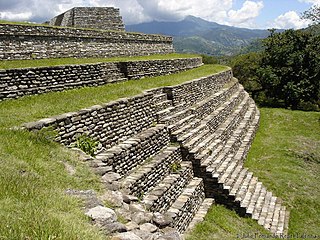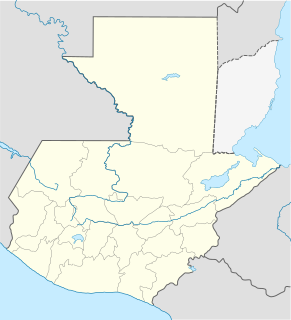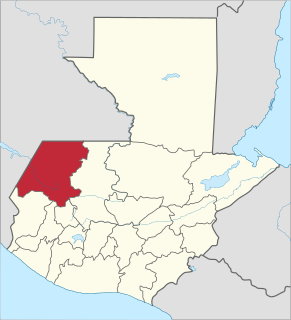
Tohil was a deity of the Kʼicheʼ Maya in the Late Postclassic period of Mesoamerica.

The Mayan languages form a language family spoken in Mesoamerica and northern Central America. Mayan languages are spoken by at least 6 million Maya peoples, primarily in Guatemala, Mexico, Belize and Honduras. In 1996, Guatemala formally recognized 21 Mayan languages by name, and Mexico recognizes eight more within its territory.

Zaculeu or Saqulew is a pre-Columbian Maya archaeological site in the highlands of western Guatemala, about 3.7 kilometres (2.3 mi) outside of the modern city of Huehuetenango. Occupation at the site dates to the Early Classic period (AD 250–600) of Mesoamerican history. Zaculeu was the capital of the Postclassic Mam kingdom, and was conquered by the K'iche' Kingdom of Q'umarkaj. It displays a mixture of Mam and K'iche' style architecture.

Qʼumarkaj, is an archaeological site in the southwest of the El Quiché department of Guatemala. Qʼumarkaj is also known as Utatlán, the Nahuatl translation of the city's name. The name comes from Kʼicheʼ Qʼumarkah "Place of old reeds".

Mixco Viejo, occasionally spelt Mixcu Viejo, is an archaeological site in the north east of the Chimaltenango department of Guatemala, some 50 kilometres (31 mi) to the north of Guatemala City and 4 kilometres (2.5 mi) from the junction of the rivers Pixcaya and Motagua. It is a moderate sized ruined city of the Postclassic Maya civilization.

The Spanish conquest of Guatemala was a protracted conflict during the Spanish colonization of the Americas, in which Spanish colonisers gradually incorporated the territory that became the modern country of Guatemala into the colonial Viceroyalty of New Spain. Before the conquest, this territory contained a number of competing Mesoamerican kingdoms, the majority of which were Maya. Many conquistadors viewed the Maya as "infidels" who needed to be forcefully converted and pacified, disregarding the achievements of their civilization. The first contact between the Maya and European explorers came in the early 16th century when a Spanish ship sailing from Panama to Santo Domingo was wrecked on the east coast of the Yucatán Peninsula in 1511. Several Spanish expeditions followed in 1517 and 1519, making landfall on various parts of the Yucatán coast. The Spanish conquest of the Maya was a prolonged affair; the Maya kingdoms resisted integration into the Spanish Empire with such tenacity that their defeat took almost two centuries.

Nentón is a municipality in the Guatemalan department of Huehuetenango. Its territory extends 762.85 km2 and has 9,113 inhabitants. It became a municipality on December 5, 1876 and was formerly known as San Benito Nentón. The population here speaks Spanish and Chuj.

San Sebastián Coatán is a municipality in the Guatemalan department of Huehuetenango. Its territory extends 560 km2, is 2,350m above sea level and has a cooler climate. It has 18,022 inhabitants who speak Spanish and Chuj. It borders San Mateo Ixtatán and Nentón to the north, San Rafael la Independencia and Santa Eulalia to the east, San Miguel Acatán to the south and Nentón to the west. Within these borders lies the archeological site called Moja'.
Chuj is a Mayan language spoken by around 40,000 members of the Chuj people in Guatemala and around 3,000 members in Mexico. Chuj is a member of the Qʼanjobʼalan branch along with the languages of Tojolabʼal, Qʼanjobʼal, Akateko, Poptiʼ, and Mochoʼ which, together with the Chʼolan branch, Chuj forms the Western branch of the Mayan family. The Chujean branch emerged approximately 2,000 years ago. In Guatemala, Chuj speakers mainly reside in the municipalities of San Mateo Ixtatán, San Sebastián Coatán and Nentón in the Huehuetenango Department. Some communities in Barillas and Ixcán also speak Chuj. The two main dialects of Chuj are the San Mateo Ixtatán dialect and the San Sebastián Coatán dialect.

Iximcheʼ is a Pre-Columbian Mesoamerican archaeological site in the western highlands of Guatemala. Iximche was the capital of the Late Postclassic Kaqchikel Maya kingdom from 1470 until its abandonment in 1524. The architecture of the site included a number of pyramid-temples, palaces and two Mesoamerican ballcourts. Excavators uncovered the poorly preserved remains of painted murals on some of the buildings and ample evidence of human sacrifice. The ruins of Iximche were declared a Guatemalan National Monument in the 1960s. The site has a small museum displaying a number of pieces found there, including sculptures and ceramics. It is open daily.

Xpuhil Pronounced:/ʃpuχil̥/ is a Maya archaeological site located in the Mexican state of Campeche, in the vicinity of the modern-day town of Xpujil. The area surrounding Xpuhil, along Federal Highway 186, is rich with other Maya sites, including Becan and Calakmul. The name xpuhil means "cat's tail" in reference to a type of vegetation found locally.
The Chuj or Chuh are a Maya people, whose homeland is in Guatemala and Mexico. Population estimates vary between 30,000 and over 60,000. Their indigenous language is also called Chuj and belongs to the Q'anjobalan branch of Mayan languages. In Guatemala, most Chuj live in the department of Huehuetenango in the municipalities of San Mateo Ixtatán and San Sebastián Coatán.

The Spanish conquest of the Maya was a protracted conflict during the Spanish colonisation of the Americas, in which the Spanish conquistadores and their allies gradually incorporated the territory of the Late Postclassic Maya states and polities into the colonial Viceroyalty of New Spain. The Maya occupied a territory that is now incorporated into the modern countries of Mexico, Guatemala, Belize, Honduras and El Salvador; the conquest began in the early 16th century and is generally considered to have ended in 1697.

Awilix was a goddess of the Postclassic Kʼicheʼ Maya, who had a large kingdom in the highlands of Guatemala. She was the patron deity of the Nijaʼibʼ noble lineage at the Kʼicheʼ capital Qʼumarkaj, with a large temple in the city. Awilix was a Moon goddess and a goddess of night, although some studies refer to the deity as male. Awilix was probably derived from the Classic period lowland Maya moon goddess or from Cʼabawil Ix, the Moon goddess of the Chontal Maya.
The Tzeltal are a Maya people of Mexico, who chiefly reside in the highlands of Chiapas. The Tzeltal language belongs to the Tzeltalan subgroup of Maya languages. Most Tzeltals live in communities in about twenty municipalities, under a Mexican system called “usos y costumbres” which seeks to respect traditional indigenous authority and politics. Women are often seen wearing traditional huipils and black skirts, but men generally do not wear traditional attire. Tzeltal religion syncretically integrates traits from Catholic and native belief systems. Shamanism and traditional medicine is still practiced. Many make a living through agriculture and/or handcrafts, mostly textiles; and many also work for wages to meet family needs.

Wajxaklajun is a ruin of the ancient Maya civilization situated adjacent to the modern town of San Mateo Ixtatán, in the Huehuetenango Department of Guatemala. Wajxaklajun is considered to be the most important archaeological site in the San Mateo Ixtatán area. The site has been dated to the Classic period. The Chuj Maya consider the city to have been built by their ancestors. The site has similarities with other nearby highland Maya ruins; it is unusual for the presence of a number of stelae, a feature more associated with lowland sites during the Classic period, probably indicating some level of exchange with lowland cities.






















